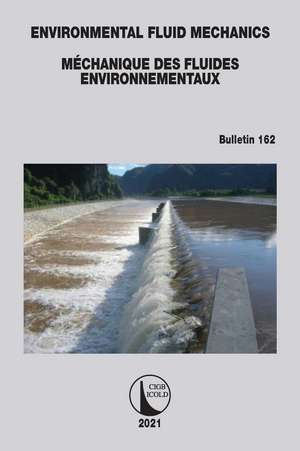Environmental Fluid Mechanics - Méchanique des Fluides Environnementaux: ICOLD Bulletins Series
Editat de CIGB ICOLDen Limba Engleză Paperback – 28 oct 2022
Despite this progress there remain significant concerns about the environmental impacts of dams. These environmental impacts are complex and far reaching, remote of the dam, and may occur in time with the dam construction or later and may lead to a loss of biodiversity and of productivity of natural resources.
This bulletin compiles improvements in knowledge and state of the art technology to avoid or mitigate environmental impacts of dams on the natural ecosystem as well as to the people that depend upon them for their livelihood and also addresses the mitigation of environmental impacts on dams and reservoirs.
Les barrages sont planifiés, construits et exploités de manière à répondre aux besoins humains. Les barrages retiennent l'eau dans les réservoirs pendant les périodes de forte crue, une eau qui peut être utilisée pour les besoins de l'homme pendant les périodes d’insuffisance des débits naturels. Les impacts positifs de barrages sont le contrôle des crues et l'amélioration du bien-être résultant du nouvel accès à l'irrigation et à l'eau potable. Sans barrages, la production alimentaire serait insuffisante pour nourrir la population du globe et l'énergie serait générée en brûlant des combustibles fossiles qui produisent des gaz à effet de serre.
Malgré ces progrès, d'importantes préoccupations subsistent quant aux retombées des barrages sur l’environnement. Les impacts environnementaux sont complexes et d’une grande portée. Ils peuvent se produire au moment de la construction du barrage ou plus tard et peuvent entraîner une perte de la biodiversité et de la productivité des ressources naturelles.
Le présent bulletin compile l'amélioration des connaissances et des technologies les plus récentes pour éviter ou atténuer les impacts environnementaux des barrages sur l'écosystème naturel ainsi que pour les personnes qui en dépendent pour leur subsistance. Il aborde également l'atténuation des impacts environnementaux sur les barrages et les réservoirs.
Preț: 637.00 lei
Preț vechi: 749.42 lei
-15% Nou
Puncte Express: 956
Preț estimativ în valută:
121.90€ • 132.37$ • 102.40£
121.90€ • 132.37$ • 102.40£
Carte tipărită la comandă
Livrare economică 22 aprilie-06 mai
Preluare comenzi: 021 569.72.76
Specificații
ISBN-13: 9781138491229
ISBN-10: 1138491225
Pagini: 188
Ilustrații: 3 Tables, black and white
Dimensiuni: 156 x 234 x 10 mm
Greutate: 0.32 kg
Ediția:1Bilingvă
Editura: CRC Press
Colecția CRC Press
Seria ICOLD Bulletins Series
ISBN-10: 1138491225
Pagini: 188
Ilustrații: 3 Tables, black and white
Dimensiuni: 156 x 234 x 10 mm
Greutate: 0.32 kg
Ediția:1Bilingvă
Editura: CRC Press
Colecția CRC Press
Seria ICOLD Bulletins Series
Public țintă
Postgraduate and ProfessionalCuprins
1. INTRODUCTION; 2. RESERVOIR WATER QUALITY; 3. MANAGEMENT OF THE IMPACT OF HYDRAULIC PROCESSES; 4. DOWNSTREAM IMPACTS OF LARGE DAMS;
Notă biografică
The Commission Internationale des Grands Barrages (CIGB) / International Commission on Large Dams (ICOLD) is a non-governmental International Organization which provides a forum for the exchange of knowledge and experience in dam engineering.
The Organization leads the profession in ensuring that dams are built safely, efficiently, economically, and without detrimental effects on the environment. Its original aim was to encourage advances in the planning, design, construction, operation, and maintenance of large dams and their associated civil works, by collecting and disseminating relevant information and by studying related technical questions.
Since the late sixties, focus was put on subjects of current concern such as dam safety, monitoring of performance, reanalysis of older dams and spillways, effects of ageing and environmental impact. More recently, new subjects include cost studies at the planning and construction stages, harnessing international rivers, information for the public at large, and financing.
The Organization leads the profession in ensuring that dams are built safely, efficiently, economically, and without detrimental effects on the environment. Its original aim was to encourage advances in the planning, design, construction, operation, and maintenance of large dams and their associated civil works, by collecting and disseminating relevant information and by studying related technical questions.
Since the late sixties, focus was put on subjects of current concern such as dam safety, monitoring of performance, reanalysis of older dams and spillways, effects of ageing and environmental impact. More recently, new subjects include cost studies at the planning and construction stages, harnessing international rivers, information for the public at large, and financing.
Descriere
This bulletin compiles improvements in knowledge and state of the art technology to avoid or mitigate environmental impacts of dams on the natural ecosystem as well as to the people that depend upon them for their livelihood.














